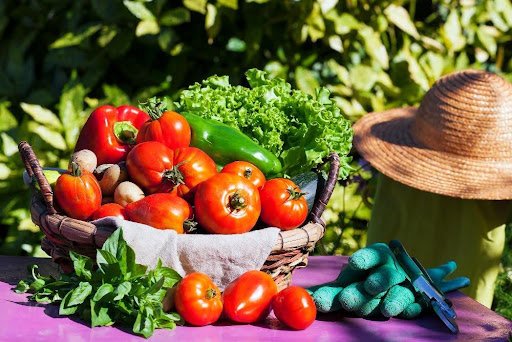Picture walking in your backyard, picking fresh veggies you grew. You can make this happen with our guide to growing your own vegetables. It doesn’t matter if you only have a small space. This book will help you enjoy the benefits of home-grown produce.
This guide helps you from start to finish, covering every step of vegetable gardening. You’ll get expert advice and simple tips. We also talk about the great things organic gardening can bring.
With info on over 40 vegetable varieties, it’s perfect for all home gardeners. Time to get your hands dirty and discover the fun and tasty world of DIY gardening. Learn about liquid fertilizer and other must-have items.
Key Takeaways
- Learn expert tips and techniques for growing a thriving vegetable garden, regardless of your space constraints.
- Discover the numerous benefits of home-grown produce, including fresh, nutritious food, cost savings, and a connection to nature.
- Explore a wide range of vegetable varieties and learn how to choose the ones that best suit your climate, growing space, and culinary preferences.
- Master essential gardening skills, from soil preparation and planting to pest management and harvesting.
- Enjoy the satisfaction of sharing your homegrown bounty with family and friends, or preserving it for year-round enjoyment.
Unleash Your Green Thumb
Growing your own vegetables is both rewarding and cost-effective. You get to enjoy tasty, fresh veggies. This section covers why starting your own vegetable garden is a great idea. You will learn about the health benefits, saving money, and helping the planet. Plus, we’ll talk about the tools and supplies you’ll need, from soil to watering cans. No matter your space, from a big yard to a small patio, we will help you get started. Let’s unleash your green thumb and grow your own vegetables.
Why Grow Your Own Vegetables?
Starting and tending to a vegetable garden comes with many perks. You watch your plants grow and produce fresh food for you. Growing your own vegetables gives you peace of mind. You know they were grown safely, without harmful chemicals.
Benefits of Home-Grown Produce
Homegrown vegetables taste great and are better for you than store-bought. When you tend to your own vegetable garden, you can pick and eat your crops when they’re most nutritious. Growing your own food saves money. It lets you shop less and be more independent.
Getting Started: Essential Tools and Supplies
Starting your vegetable garden needs some key tools. You’ll need a good potting mix, a well-balanced liquid fertilizer, and something to water with. You might also like raised beds, pots, or a vertical garden to use space well. With the right stuff and a little learning, you can have a lush kitchen garden or edible landscape.
Planning Your Vegetable Garden
Starting a great vegetable garden needs smart planning. Choosing the right place and a good design is key. These first choices will make sure you have plenty to harvest all season.
Selecting the Perfect Location
A good location is vital for your garden. It should get 6-8 hours of sunlight each day for most veggies to grow well. Make sure the soil drains well and there are no large roots or shading structures nearby.
For those just starting out, raised beds of 4′ x 4′ or 4′ x 8′ are a good choice. For more room, try a 12′ x 24′ plot. This size can support various vegetables to feed a family of four.
Designing Your Garden Layout
After picking the right spot, it’s time to plan your garden’s shape. You can choose to plant in rows with spaces between, or more closely. Either way, using your space well is important.
Remember not to crowd your plants. They need room to grow without fighting for sunlight or nutrients. Aim for 4-6 plants of each type in a family plot to stay productive and easy to manage.
Choosing Suitable Varieties
Now, choose which veggies to plant. Think about your climate, how much space you have, and what your family likes to eat. For those new to gardening, try radishes, lettuce, cucumbers, peppers, and carrots. These are easy and quick to grow.
Also, look into heirloom and hybrid varieties for different tastes and benefits. Do mix in some crops that like cooler weather with those prefering it warm. This way, you can have fresh veggies all year long by planting at different times.
Use online tools and calendars to help you plan. They can make figuring out your garden setup and planting schedule easier. And many of these tools have a free trial so you can see what works best before committing.
Soil Preparation and Planting
Starting a successful vegetable garden means knowing the soil must be healthy. We’ll look at how to improve your garden soil for the best growth. You’ll also find out the top ways to plant seeds and move young plants, making sure they start well. This is whether you’re starting from nothing or refreshing an older garden.
Understanding Soil Health
The best soil for vegetables is a deep, rich mixture full of nutrients and living organisms. This type of soil, called loam, is made of equal parts sand, silt, and clay. Loam is great because it keeps moisture, drains well, and offers lots of oxygen to the roots. It’s easy to work with and has plenty of organic materials for plants to thrive.
If the soil is sandy, it dries out quickly but provides good aeration. Clay soil, however, holds water but lacks air and can get waterlogged. Adding organic matter like compost improves both sandy and clay soils. It makes sandy soil retain more water and nutrients, and it helps clay soil drain and get more oxygen to the roots.
Amending and Enriching Your Soil
Getting your vegetable garden’s soil ready the right way is key for your plants’ health. Mix about two to three inches of compost in the soil a month before planting. This helps all soil types by keeping moisture and nutrients in sandy soil and improving drainage in clay soil. A good pH level for a vegetable garden is around 6.5, but most veggies do well between 6.0 and 7.2.
Tilling the soil is also crucial to prepare it. This step breaks up compact soil and mixes in improvements. Yet, too much tilling can harm the soil’s structure. For very tough soil, consider double-digging to loosen the deep soil. This method is useful for enhancing drainage and aeration.
Sowing Seeds and Transplanting
After the soil is ready, planting time has come. Choose fresh seeds for the best results. Older seeds might not grow as well and may need more for a good yield. Transplant young plants carefully, keeping in mind that tomato plants should have space around them when they’re big. Raised beds are a smart choice because they improve drainage, warm up faster in spring, and stop weed invasion.
In this section, you’ve learned how to prepare your garden for planting, improving soil health. Use these tips about soil, enriching it, and the right way to plant. You’ll see your vegetable garden flourish with these steps.
Grow Your Own Vegetables: Essential Techniques
Creating a successful vegetable garden needs careful planning. This part will teach you vital skills to maintain healthy and productive plants. You will learn the best ways to water, fertilize, and prune your garden. Each vegetable type needs a unique approach to thrive. With the right know-how, you can grow amazing vegetables at home.
Watering for Optimal Growth
Keeping your plants well-watered is key to avoiding wilting and increasing your harvest. Vegetables usually require direct sunlight for 6 to 8 hours a day. The water they need changes based on weather, ground type, and their growth stage. Make sure the soil stays moist but not soaked to have strong roots and happy plants.
Setting up timers for your watering systems can be a great way to make sure your plants get the right amount of water. This can also help you save water and money.
Fertilizing and Feeding Your Plants
Starting with healthy soil is vital for a successful vegetable garden. Test your soil to find out if it lacks any essential nutrients or if its pH balance is off. Add potting soil, compost, and other organic material to make the soil retain moisture better and keep the air flowing. Use either a liquid or a slow-release fertilizer to give your plants the nutrients they need for strong growth.
Pruning and Training Techniques
Pruning and training your plants can make them better producers. For plants that climb or spread, like tomatoes or squash, use techniques like staking or trellising. These help the plants grow up rather than out, saving space in your garden. By removing any unhealthy or unnecessary parts, you help the plant focus on giving you more and healthier vegetables.
Pest and Disease Management
Every vegetable garden can face pests and diseases. But, by taking the right steps, you can reduce their harm and keep your plants strong. It’s key to know how to spot and deal with common problems. This knowledge is essential to safeguard your harvest, whether you garden in a backyard, a city spot, or containers.
Identifying Common Pests and Diseases
In vegetable gardens, you might see many pests and diseases. This includes things like fungi and viruses. Georgia can have a lot of vegetable diseases when it’s warm and wet. It’s a perfect time for fungi, bacteria, nematodes, and viruses to spread. Nematodes harm plant roots, which cut down on growth and harvest. They’re not the only ones – soil diseases can affect many plant types. To fight these problems, you must first know what to look for.
Organic and Natural Pest Control Methods
Instead of using strong chemicals, you can opt for organic and natural ways to control pests. For example, some plants can keep pests away if planted next to each other (companion planting). You can also use pesticides made from plants. These methods are quite effective. It’s also good to change where you grow your crops each year. This is called crop rotation and it helps stop diseases from spreading. Managing pests naturally while protecting your garden is a smart and eco-friendly choice.
Harvesting and Preserving Your Bounty
The best part of gardening at home is the harvest. You will learn the best times and ways to pick your veggies. This ensures you make the most of what your garden has grown.
After picking, you will find out how to keep your veggies fresh. This way, you can enjoy them even after the growing season. We will talk about curing, dehydrating, freezing, and canning to keep your harvest for longer.
When and How to Harvest Vegetables
Picking your vegetables the right way makes them taste better and keeps their nutrients. Each type of vegetable is different. Some, like kale, need to be picked often to keep growing. Others, like carrots, are ready when you see their tops above the ground.
Storing and Preserving Techniques
There are many ways to keep your veggies for later. Methods include curing, dehydrating, freezing, and canning. Each method is perfect for different types of vegetables.
For example, curing works well for potatoes and onions. Dehydrating is good for fruits and veggies like apricots and tomatoes. Freezing with proper blanching helps keep the taste and feel of beans and kale. Lastly, pressure canning is a must for low-acid foods like beans. But, canning needs to follow certain rules to be safe.
Recipes for Fresh Homegrown Vegetables
Now that you’ve stored your veggies, it’s cooking time. Find exciting recipes to use your homegrown produce. There are simple dishes as well as more complicated ones. They all highlight the great taste of your veggies.
Extending the Growing Season
In colder places like Wyoming or New England, the growing season is usually short. This is because the weather can be very unpredictable. But, there are ways to keep your garden growing strong. You can use special methods to protect plants from frost and make the growing conditions better. This way, you can have lots of fresh veggies even in fall and winter.
Cold Weather Gardening Strategies
During colder months, you can keep growing if you use cold frames, hoop houses, and cloches. Cold frames are like small houses for your plants. They keep them warm and safe from frost. Hoop houses work by creating a warm pocket of air around your plants. They can make your growing season last longer, up to 8 weeks more. And then there are cloches, small protective covers that act like a greenhouse for each plant, protecting them from bad weather.
Warm Weather Gardening Techniques
Summer can be tough on plants, but there are ways to help them. Setting up shade can keep some plants happy. Awnings or canopies can do the trick. Watering wisely is also important. Methods like drip systems and mulching can save water and keep your plants cool. If you have a small space, like in the city, try growing in containers or raised beds. This can make managing the heat a bit easier.
With the right techniques, you can grow veggies all year round. These tips work whether it’s cold or hot outside. They help you make the most of your garden, giving you fresh food whenever you want it.
Gardening for Small Spaces
Don’t worry if you don’t have much space. You can still grow your own veggies. We’ll look at using pots and soil for small areas. You’ll learn how to grow more by going up.
There are small veggies that do well in tiny spots, like dwarf tomatoes. This guide is perfect for anyone with just a little space. So, get ready to turn your balcony, patio, or sunny window into a green haven.
Container Gardening Basics
Container gardens are great if you’re starting out or have a small area. They’re easier to take care of than gardens in the ground. Plus, plants in containers usually taste better, and fighting pests is easier.
Think about your veggie’s size when picking pots. Tomatoes, for example, need big pots. Use special soil for containers, and feed plants regularly to keep them healthy.
Vertical Gardening Solutions
A container garden brings beauty and fresh food to any tiny space. It also makes our planet greener. Herbs and fruit trees grow well in pots too.
Compact Vegetable Varieties
Start with seedlings if you’re low on space but have some cash. When to plant depends on your area’s sunlight and temperature. Remember, veggies love the sun and good soil.
| Vegetable Type | Container Size Recommendation |
| Tomatoes | 5- to 10-gallon pot |
| Herbs and Leafy Greens | Small containers or hanging baskets |
| Fruiting Plants (Peppers, Eggplants, Cucumbers) | 5-gallon containers or larger |
With the info here, anyone can have a lush garden. No matter how small their space is. Ready to grow your own and taste the difference? Let’s get planting!
Conclusion
This guide has given you all you need for a successful vegetable garden. You’ve learned how to plan, plant, and preserve like a pro. Now, you can enjoy the many perks of growing your own produce. These include great-tasting food, saving money, and feeling closer to nature.
It doesn’t matter if you have a big backyard or a tiny patio. You now have the tips and tools to make the most of any space. With info on container gardening, vertical gardening solutions, and compact vegetable varieties, you can enjoy a rich kitchen garden.
Get ready to love vegetable gardening and its yummy rewards. This guide is for anyone, whether you’ve just started or have lots of experience. It shows you how to succeed in urban or organic gardening. Now, you can savor the taste of fresh vegetables all year, save money, and help the planet.
FAQ
What are the benefits of growing your own vegetables?
Growing your own vegetables has many advantages. These include having fresh and healthy food. You can save money and reduce waste.
It also helps the environment and connects you with nature.
What essential tools and supplies do I need to get started?
Starting a garden requires some key items. You’ll need soil enhancements, planting pots, or raised beds. Don’t forget a watering can, basic garden tools, and seeds.
How do I choose the best location for my vegetable garden?
Choose a spot with plenty of sunlight. Check that the soil drains well. This will create the best conditions for your plants to grow.
How do I prepare the soil for planting?
Good soil is key for a great garden. Scan your soil and add things like compost to fix its nutrients. Doing this improves its structure too.
What are the best techniques for watering and fertilizing my plants?
Watering and feeding your veggies right is vital. Too little or too much can harm them. Adjust your water and nutrients to what each plant likes.
How can I prevent and manage pests and diseases in my garden?
Keep your garden healthy by watching out for pests and diseases. Use natural ways to control them. This keeps your veggies in great shape.
When and how should I harvest my vegetables?
Knowing the right time and way to pick your veggies is key. This keeps them tasting their best. Look up how each type should be harvested.
How can I extend my growing season and enjoy vegetables year-round?
You can grow veggies all year using some special techniques. Cold frames or shade can help. These methods let you enjoy fresh veggies even in the winter.
Can I grow vegetables in small spaces like containers or balconies?
Absolutely! You can do a lot with a little space. Use containers or vertical gardening for small areas. Pick veggies that don’t need a lot of room.


















